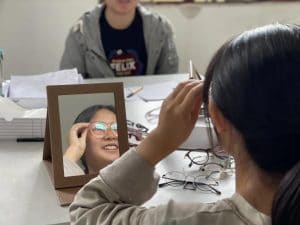“We say education changes rural children’s lives; but how can their lives be changed by education if they cannot even see the blackboard clearly?” Yang Jin asked during a recent interview with CDB.
As the secretary-general of Education in Sight, an organization that aims to provide free glasses to students from deprived backgrounds, Yang has been trying to answer her own question.

Growing up in a little town named Longling in Yunnan Province, near the border with Myanmar, Yang believes her life was changed by a pair of glasses. When she was in Grade Four in primary school, she was told by a teacher to see an optometrist due to problems with her vision. Yang’s father took her on a three-day journey to the provincial capital Kunming to get her very first pair of glasses; they felt strange, heavy, and the lenses were as thick as a beer bottle, yet from the moment she first tried them on, the whole world started to look clearer. Finally, Yang was able to see the blackboard clearly at school.
Later, after finishing high school, she left her hometown for university. She eventually settled in Beijing and went to work in the corporate sector, living a very different life to many of her peers back in Yunnan.
In the two decades since Yang got her first pair of glasses, Longling has undergone significant change. It has better roads and facilities, although there are still few bus routes serving the city. Most people in villages continue to use motorbikes or tractors to transport people and goods. The city still does not have any ophthalmology hospitals. The handful of opticians in the area cannot meet local demand and they are often unaffordable for local residents.
Many children in rural Yunnan live with their grandparents while their parents work in far-away cities. Often, members of the older generation don’t understand the importance of wearing corrective glasses, and those that do are forced to make long journeys to buy glasses for their grandchildren. Expectations that children will end up working as farmers often mean a child’s eyesight is given a low priority.
Education in Sight was founded by Andrew Shirman and Sam Waldo, two American volunteer teachers who joined the Teach for China (TFC) program and taught in Yunnan Province for two years. During their time working in schools, the pair realized that students unable to afford glasses were a common problem, and this had a direct impact on their performance at school. Attempting to solve the issue, the pair set up Education in Sight in 2012 and raised funds to support its operations.
Yang’s encounter with the organization was through Teach for China. After helping with one of TFC’s programs in Yunnan, she started to seriously consider the possibility of leaving the corporate sector and working for a charity. Yang took the first step and joined TFC’s Yunnan office in 2012. During her time with the organization, she heard about Education in Sight from colleagues and was impressed with the work Shirman and Waldo were doing.
“I had goosebumps when I first heard about it!” exclaimed Yang. “They are trying to solve an issue that has been largely ignored.” When she finished working for TFC and decided to move back to Beijing, she learnt that Education in Sight was undergoing some internal changes and urgently needed more full-time staff. “I went to see Sam Waldo and realised there was a lot that needed doing there. Also, I knew I could relate to the work because I have suffered from myopia for years, and I totally understand what glasses mean to people like myself,” she said. Shortly after her meeting with the American, Yang joined Education in Sight as its second full-time member of staff.
So far, most of the organization’s programs have taken place in rural Yunnan, covering 1,055 schools in 10 counties and providing children with a total of 409,313 check-ups in nine newly- opened vision centers. It has so far distributed 54,559 pairs of glasses. Choosing Yunnan as their main area of operations isn’t just because of the connections Shirman, Waldo and Yang have to the area. The situation in the province is similar to other less-developed regions of China. Yang said that after the huge national poverty alleviation program, facilities in the area have improved. “In the past, you could see dilapidated buildings used as students’ classrooms and dormitories, but now, the local school is often the best building in the village,” she said.

While changes on the outside are indeed impressive, people’s attitudes can still be a problem. The actual gap between rural and urban areas is still huge. For example, when children in urban cities have vision problems, it is very natural for parents to take them to a hospital or an optician for regular check-ups. Afterwards, children will be given glasses to wear or receive other treatments. But in rural areas children sometimes do not even know how to read an eye chart. “I remember once we went to a village school. We noticed that most of the children reacted rather slowly to the eye chart and at first, we thought all of them had poor vision. But later, we realised that they simply didn’t know how to read the eye chart – they had never seen one before!”
Some may question the causes of vision problems in rural areas, as people might assume that children do not spend as much time on phones and computer games as their urban counterparts. Yang told CDB that there are three main reasons that lead to poor vision in rural children.
“Some were born with eye disorders and diseases related to their genes. This is a very unfortunate group because many of them may not be able to receive timely or sufficient treatment due to the high cost and time required,” she explained. “The second reason is quite similar to children in cities: they spend too much time staring at their phones. Without proper guidance and discipline and quality time spent with family or friends, children end up spending all their spare time on their phones, which can significantly harm a person’s vision.” The third reason relates to everyday habits. “No one has told the children how to use their eyes safely, so they are left to do things their own way. Some of the children I met at our program told me that they do not do their homework in a dark room, instead they do it in the sun because the light is very bright.”
Shocking as these situations are, Yang continues to see progress in the villages, and that is what keeps her going despite the difficult conditions both within the organization and in the field. For a long time, Shirman and Yang were the only full-time staff at Education in Sight. This meant that Yang had to juggle multiple roles, from program designer and assessment officer in the office, to program officer in the field, as well as serving as secretary-general when talking to potential donors. Labor is one problem, and funding is another big concern. There have been times when Yang has had to pay the organization’s bills out of her own pocket.
Before a new program is launched, there are numerous procedures that Yang has to go through with several departments of the local government, in addition to communicating with local schools, communities, hospitals, opticians and individuals. Misunderstandings can easily arise and lead to disagreement, and it is not an easy job to keep all the various stakeholders satisfied.

As someone who has changed careers, Yang admitted that charity work is more complicated than working in the private sector. “We are not making profits through our work at Education in Sight,” she said. “Our one and only objective is to help students with vision problems. This may sound like a simple task, but we have encountered obstacles from all sides. And the infrastructure of the charity sector has not been supportive, either.”
But all her hard work has not been in vain. Changes in behaviours and attitudes have gradually become apparent. “When we launch a new program in a local school, during the first semester many parents are likely to refuse to let their children wear glasses. But by the time of the second, third and fourth semesters, we start to see more and more parents happy to let their children wear glasses, with their sons and daughters becoming more outgoing and performing better at school. Parents who used to reject the program will even come to us and ask us to do check-ups on their children, and that’s really exciting!” Yang told CDB.
This is part one of CDB’s interview with Education in Sight’s Yang Jin. You can read part one here.



